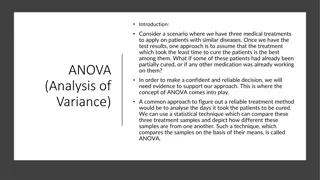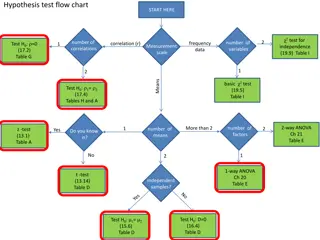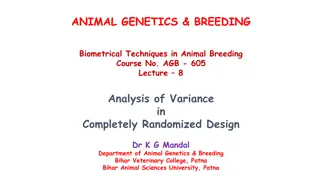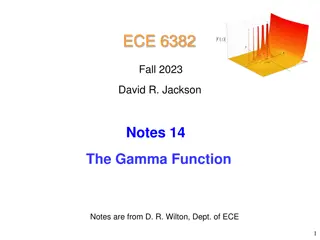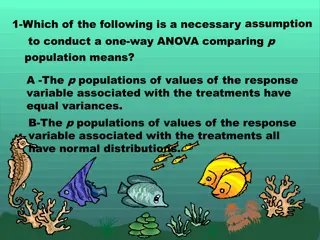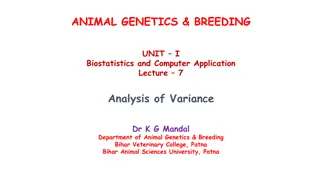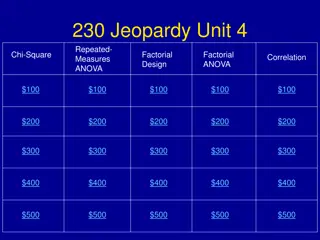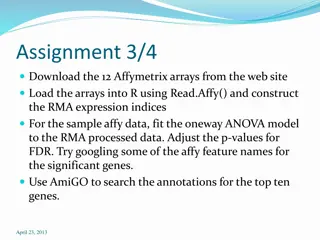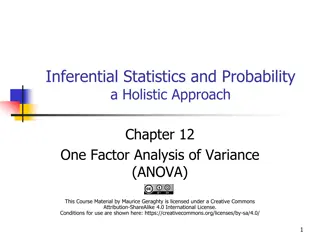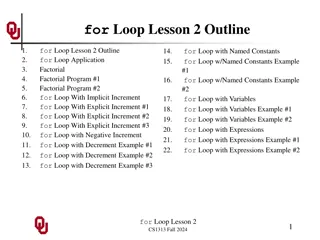FACTORIAL ANOVA
Dr. Petrov plans an experiment to study the impact of teaching methods and sex differences on learning outcomes using factorial ANOVA. The design includes row and column factors, with different levels for each, to analyze the data effectively. The means tables provide a summary of the experiment's data, showing results for male, female, and other groups across different teaching methods. This experiment encompasses various statistical concepts, such as 1-way ANOVA, 2-way ANOVA with a 2X3 factorial design, and more. Understanding these concepts is essential for conducting meaningful research in education.
Download Presentation

Please find below an Image/Link to download the presentation.
The content on the website is provided AS IS for your information and personal use only. It may not be sold, licensed, or shared on other websites without obtaining consent from the author.If you encounter any issues during the download, it is possible that the publisher has removed the file from their server.
You are allowed to download the files provided on this website for personal or commercial use, subject to the condition that they are used lawfully. All files are the property of their respective owners.
The content on the website is provided AS IS for your information and personal use only. It may not be sold, licensed, or shared on other websites without obtaining consent from the author.
E N D
Presentation Transcript
Chapter 14 FACTORIAL ANOVA Adapted from Jamison Fargo, PhD EDUC 6600 Slides
People can be divided into two classes: Those who go ahead and do something, and those who sit still and inquire, 'Why wasn't it done the other way? Oliver Wendell Holmes American Physician, Writer, Humorist, HarvardProfessor 1809-1894
Dr. Petrov is interested in conducting an experiment where: r = # rows c = # columns r x c 1-way ANOVA: GROUPING FACTOR Teaching method k = 2 30 high school students are randomly assigned to a new computer simulation tool for learning geometry and 2-way ANOVA: COLUMN FACTOR Teaching method c = 2 30 other students are randomly assigned to the standard lecture and paper/pencil problem solving format. However, Dr. Petrov is also interested in the effect of sex differences on learning outcomes. 2-way ANOVA: ROW FACTOR Sex r = 3 3
r = # rows c = # columns ANALYSIS OF VARIANCE r x c Independent ANOVA types 1-Way ANOVA = 1 factor (previously covered) The # levels of each factor determines ANOVA design Row factor = 2 levels Column factor = 3 levels 2-way ANOVA with a 2X3 factorial design 2-Way ANOVA = 2 factors (focus of lecture) 3-Way ANOVA = 3 factors Row factor = 4 levels Column factor = 2 levels 2-way ANOVA with a 4X2 factorial design 4-Way ANOVA = 4 factors 4
MEANS TABLE Summary of data
Means Table: r = 3 rows c = 2 columns 3 x 2 lecture and paper/pencil problem computer simulation tool Margin 2-way ANOVA: ROW FACTOR Sex r = 3 Male Female Other Grand Mean Mean of ENTIRE sample s Outcome (DV) MG Margin 2-way ANOVA: COLUMN FACTOR Teaching method c = 2 6
Means Table: r = # rows c = # columns 3 x 2 lecture and paper/pencil problem computer simulation tool Margin 2-way ANOVA: ROW FACTOR Sex r = 3 M1 Male M2 Female Row Means Marginal Means for Rows M3 Other Grand Mean Mean of ENTIRE sample s Outcome (DV) MG Margin 2-way ANOVA: COLUMN FACTOR Teaching method c = 2 7
Means Table: r = # rows c = # columns 3 x 2 lecture and paper/pencil problem computer simulation tool Margin 2-way ANOVA: ROW FACTOR Sex r = 3 M1 Male M2 Female Row Means Marginal Means for Rows M3 Other Grand Mean Mean of ENTIRE sample s Outcome (DV) 1 2 MG Margin Column Means Marginal Means for Coumns 2-way ANOVA: COLUMN FACTOR Teaching method c = 2 8
Means Table: r = # rows c = # columns 3 x 2 lecture and paper/pencil problem computer simulation tool Margin 2-way ANOVA: ROW FACTOR Sex r = 3 11 12 M1 Male 21 22 M2 Female Row Means Marginal Means for Rows M31 32 M3 Other Grand Mean Mean of ENTIRE sample s Outcome (DV) 1 2 MG Margin Column Means Marginal Means for Coumns Cell Means Interior Means for Each Cell 2-way ANOVA: COLUMN FACTOR Teaching method c = 2 9
THE BASICS Statistical significance of effects
FACTORIAL 2-WAY ANOVA r = # rows c = # columns r x c Simultaneously evaluate effect of 2 or morefactors effects on a continuous outcome AND investigate a potential 3rd effect: an interaction between the two factors. Typical 2-way ANOVA 3x2 design Row factor ( A ): 3 levels Column factor ( B ): 2 levels B B1 11 21 31 B2 12 22 32 Cross-classification: A1 A2 A3 Participants only belong to 1 mutually exclusive cell A Belong to 1 level of row factor Belong to 1 level of columns factor 11
r = # rows c = # columns r x c TEST OF ROW MAIN EFFECT Do row marginal means differ? Do population means differ across levels of row factor, averaging across levels of column factor? B B1 M11 M21 M31 B2 M12 M22 M32 MB2 Marginals MA1 MA2 MA3 H0: 1 = 2 = = r A1 A2 A3 H1: Not H0 A Marginals MB1 12
r = # rows c = # columns r x c TEST OF COLUMN MAIN EFFECT Do column marginal means differ? Do population means differ across levels of column factor, averaging across levels of row factor? B B1 M11 M21 M31 B2 M12 M22 M32 MB2 Marginals MA1 MA2 MA3 H0: 1 = 2= = c A1 A2 A3 A H1: Not H0 Marginals MB1 13
TEST OF INTERACTION EFFECT B B1 M11 M21 M31 B2 M12 M22 M32 MB2 Marginals MA1 MA2 MA3 Does pattern of cell means differ? A1 A2 A3 A Are differences among population means across row factor similar across all levels of column factor (and vice versa)? Marginals MB1 B B1 M11 M21 M31 B2 M12 M22 M32 MB2 Marginals MA1 MA2 MA3 H0:Differences among levels for 1 factor do not vary across levels of other factor A1 A2 A3 A H1: Not H0 Marginals MB1 14
POSSIBLE OUTCOMES: ORDER TO INVESTIGATE 1. Significant Interaction and Always check for FIRST Always interpret FIRST Exercise EXTREME caution interpreting significance and effect of main effects 2. No significant interaction, but Significant main effects for bothrows and columns Significant of onlymain effect for rows, but not for columns Significant of onlymain effect for columns, but not for rows 3. No significance main effects or interaction(s) 15
IGNORING FACTORIAL DESIGN Treat each cell as a separate group (e.g., M/Rep, M/Dem, F/Rep, F/Dem) and run analysis as 1-Way ANOVA with R*C groups? Results in same SSBetween as factorial design (SSR + SSC + SSRC ; when study is balanced) Cannot see patterns in data, as all levels of all factors are blended together in each group Cannot as easily observe interaction effects Limits identification of characteristics that uniquely differentiate participants More cumbersome when many factors included Less powerful 16
REDUCED ERROR Adding factors that explain subject-to-subject variability in outcome reduces MSW& increases power Subject-to-subject variability contributes to increased MSW => Less power Variance within (and thus across) individual cells is reduced as cases become more homogeneous in terms of their characteristics Factors that do not have this effect may slightly decrease power dfW=N rc Alternatives: Restriction (subjects from 1-level only reduced generalizability) Repeated-measures (matched) designs decreases as # cells increases, increasing MSW& decreasing F-ratios 17
ASSUMPTIONS Can NOT test or fix this You can only can PLAN well Look at the PLOT {histogram, QQ plot, boxplot} of the OUTCOME, for each cell s subsample Similar to 1-Way ANOVA Independence (observations) Outcome is normally distributed in EACH population Homogeneity of variance in EACH population Run Levene s Test of HOV for all cell s subsample 18
OMNIBUS F-TESTS Statistical significance of effects
ANOVA SUMMARY TABLE: 4-SUM OF SQUARES 1-Way ANOVA 2-Way ANOVA SS df MS F p Source SS df MS F p Source Row Group Column Within R x C Total Within Total 20
PARTITIONING TOTAL VARIANCE (SSTOTAL) For balanceddesigns (all cells are the same size) GROUPING Effect k = # groups SSTotal = SSBetween-Groups + SSWithin-Groups 1-Way ANOVA 2-Way ANOVA SSTotal = SS(R)ows + SS(C)olumns + SSRC + SSWithin-Cell INTERACTION Effect r x c = # cells COLUMN Main Effect c = # columns ROW Main Effect r = # rows 21
SSR Computed with row means: all scores in a given row are averaged, regardless of column Grand Mean Mean of ENTIRE sample s Outcome (DV) Row Means Marginal Means for Rows nrow= # participants per row = + + ... ( + 2 2 2 [( ) ( ) ) ] SS n X X X X X X 2 Alternative Forms, Give the same value 1 2 R row row GM row GM row r GM 2 2 2 2 n n n n + + + ... X X X X 1 2 row row row r = = = = = 1 1 1 1 i i i i SS R n N row 22
SSC Computed with column means: all scores in a given column are averaged regardless of row Column Means Marginal Means for Columns Grand Mean Mean of ENTIRE sample s Outcome (DV) ncol= # participants per column = + + ... ( + 2 2 2 [( ) ( ) ) ] SS column n X X X X X X 2 Alternative Forms, Give the same value 1 2 C col GM col GM col r GM 2 2 2 2 n n n n + + + ... X X X X 1 2 col col col r = = = = = 1 1 1 1 i i i i SS C n N col 23
SSRC Variability among cell means AFTER REMOVING variability due to individual row and column effects Grand Mean Mean of ENTIRE sample s Outcome (DV) Cell Means Interior Means for Each Cell ncell= # participants per cell 2 Alternative Forms, Give the same value = + + ... ( + 2 2 2 [( ) ( ) ) ] SS n X X X X X X SS SS 11 12 RC cell cell GM cell GM cell rc GM R C 2 2 2 2 n n n n + + + ... X X X X 11 12 cell cell cell rc = = = = = 1 1 1 1 i i i i SS SS SS RC R C n N cell 24
SSW SS within each cell added together SSW = SS11 + SS12 + + SSrc For each cell, all scores within that cell are subtracted from cell mean, squared, and summed 3 Alternative Forms, Give the n rc ( ) rc 2 = SS X X W irc rc 1,1 = = 1 j i same value 2 2 2 n n n + + + ... X X X 11 12 cell cell cell rc n = = = = 1 1 1 i i i 2 i SS X W n = 1 i cell = SS SS SS SS SS W T R C RC 25
ANOVA SUMMARY TABLE: DEGREES OF FREEDOM 1-Way ANOVA 2-Way ANOVA SS df MS F p Source SS df MS F p Source Row Group Column Within R x C Total Within Total 26
2-way or factorial (Ch 14) n = # obs per cell r = # rows c = # columns nT = total # observations DEGREES OF FREEDOM: df 1-way or independent groups (Ch 12) n = # obs per group k = # groups nT = total # observations 27
ANOVA SUMMARY TABLE: VARIANCE ESTIMATES 1-Way ANOVA 2-Way ANOVA SS df MS F p Source SS df MS F p Source Row Group Column Within R x C Total Within Total 28
4X VARIANCE ESTIMATES: MS ????????=???????? ???????? Variance Estimate MSR MSC MSRxC MSW Effect of Sensitive to effect of Row s Factor Name Row-wise Factor Column s Factor Name Column-wise Factor Interaction between the Row-wise & Column-wise Factors Interaction Within-Cell, Residual, or Error None of the Factors (noise) 29 Note MSWithin is also called MSW , MSError , MSResidual , or MSE
ANOVA SUMMARY TABLE: OMNIBUS F-TESTS 1-Way ANOVA 2-Way ANOVA SS df MS F p Source SS df MS F p Source Row Group Column Within R x C Total Within Total 30
3X F-STATISTICS (F-ratio or F-test) P-VALUES ???????=???????? ????? ?? The Denominator (bottom) of each F-ratio and df s are the same for all 3 F-tests Degrees of Freedom numerator F-stats Effect of denominator Row s Factor Name Column s Factor Name FR FC FRxC dfR = r - 1 dfWithin = nT (r x c) dfC = c - 1 dfWithin = nT (r x c) dfR x C = (r 1) x (c - 1) dfWithin = nT (r x c) Interaction NOTE Since each F-test CAN have a different numerator df, the critical values (FCV) may all be different 31
EFFECT SIZE How big is the effect?
Proportion of variation in outcome accounted for by a particular factor or interaction term EFFECT SIZE ???????? ?2=???????? ??????? Interpretation: Range: 0 to 1 Small: .01 to .06 Medium: .06 to .14 Large: > .14 Eta-squared ( 2) 1-way ANOVA SSBetween / SSTotal 2-way ANOVA Row factor: SSR / SSTotal Column factor: SSC / SSTotal Interaction: SSRC / SSTotal 34
EFFECT SIZE should but people dont 2 are biased parameter estimates Should estimate omega squared ( 2) Substitute SSand df values * SS df MS Effect SS Effect MS + Within = 2 Total Within Same interpretation as 2 35
EFFECT SIZE PARTIAL When all factors are experimental or when many factors are included in analysis, SS due to a factor or interaction will be small relative to SSTotal Partial effect size estimates are often reported Proportion of variation in outcome accounted for by a particular factor or interaction term, excluding other main effects or interaction sources of variation SS Effect SS + 2 Partial = SS Effect Within ( )/ ] + df MS MS N MS Effect MS Effect MS Within N = 2 Partial [ ( )/ df Effect Effect Within Within 36
INTERACTIONS Moderation of effects
INTERACTIONS: aka Moderation Interaction between 2 factors is called a 2-way interaction 3 factors is called a 3-way interaction Quite rare, be skeptical BUT I have found/published them ;) Significance indicates that the effect of 1 factor is not same at all levels of another factor i.e. the effect of 1 factor depends on the level of the other Effect of variables combined is different than would be predicted by either variable alone Most interesting results, but more difficult to explain or interpret than main effects 38
INTERACTIONS Ordinal Disordinal Direction or order of effects is similar for different subgroups Direction or order of effects is reversed for different subgroups 6 100 Male Female M Phonemic Errors Mean Test Score 90 5 80 4 70 3 High SES Low SES 60 2 50 1 40 0 Control Treatment LTLE RTLE Study Group Hemisphere 39
INTERACTIONS Significance of interaction always evaluated 1st If significant, interpret interaction, not main effects If non-significant, interpret main effects Once we know effects of 1 factor are tempered by or contingent on levels of another factor (as in an interaction), interpretation of either factor (main effect) alone is problematic Best interpreted through visualization Cell means plot Interactions exist if lines cross or will cross (non- parallel) Design graph to best illustrate Outcome on y-axis Select one factor for x-axis Other factor(s) represented by separate lines, colors, panels, ect. Selection guides interpretation, can dictate whether plot is ordinal/disordinal
INTERACTIONS It is Recommend to only interpreting significant main effects (Keppel & Wickens, 2004) IF 1. there is NO significant interaction 2. there is a significant interaction WITH EXTREME CAUTION, IF interaction effect size is small relative to that of main effects and there is an ordinal pattern to the means However, must report all main and interaction effects regardless of statistical significance 41
NEED FOR TESTING INTERACTIONS Results may be distorted if additional factors are not included in analysis so that interactions are not tested E.g., If experimental effects of a drug had opposite effects in men and women, the variable representing drug effects may appear to be ineffective (non-significant main effect) without including the variable for sex differences If interaction terms are non-significant, increased confidence that effect of key factor (e.g., drug treatment) is generalizable to all levels of other factors (e.g., sex) 42
FOLLOW-UP TESTS Prob Interactions, Post Hoc, a prior
MULTIPLE COMPARISONS FOLLOW IT UP Factorial ANOVA produces omnibus results It does NOT indication of specific level (group) differences within or across factor(s) Multiple comparisons elucidate differences within significant main effects or interactions Pattern of results dictates approach (eg. Significant main effects, but no interaction) Each of the 3 F-tests in a 2-Way ANOVA represents a planned comparison No adjustment to EWnecessary However, within each main-effect and interaction a separate family of possible multiple comparisons may be conducted ( EWmust be controlled within each family ) 44
SIGNIFICANT INTERACTION Simple main effects generally tested within each level of stratifying factor 2-levels Simple, pairwise comparisons: Tukey HSD or t-tests with Bonferroni correction > 2 levels Modified 1-way ANOVA followed by simple or complex comparisons B B1 M11 M21 M31 B2 M12 M22 M32 MB2 Marginals MA1 MA2 MA3 A1 A2 A3 A Marginals MB1 B B1 M11 M21 M31 B2 M12 M22 M32 MB2 Marginals MA1 MA2 MA3 A1 A2 A3 A Marginals MB1 45
SIGNIFICANT INTERACTION Modified 1-Way ANOVA tests of simple main effects often done by hand Obtain MSBetween from standard 1-Way ANOVA Comparing means across 1 level of 1 factor within 1 level of another factor Obtain MSWithin from original 2-Way ANOVA Ensure homogeneity of variance assumption is reasonably satisfied MS MS (1-way ANOVA) Between = Simple Effect F (2-way ANOVA) ) from 1-way ANOVA Within df Within ( , Critical F df Between 46
INTERACTION CONTRASTS An alternative is to perform interaction contrasts , rather than immediately testing simple effects With a 2x2 design, only tests of simple main effects are possible With a 2x3 design, 3 separate 2x2 ANOVAs may be conducted Interaction magnitude (and significance) can differ from one subset to another Simple effects can be used following significant interaction subsets MSB for overall interaction = average of MSInteractionsfor separate interaction subsets 47
NON-SIGNIFICANT INTERACTION The you may evaluate possible significant main effect Factors with 2 levels No multiple comparisons required Factors with > 2 levels 2-way ANOVA is reduced to two 1-Way ANOVAs Simple (pairwise) or complex (linear) contrasts are computed within individual significant main-effect(s) (ignoring others) 48
NON-SIGNIFICANT INTERACTION Significant main-effects B B1 M11 M21 M31 B2 M12 M22 M32 MB2 Marginals MA1 MA2 MA3 A1 A2 A3 Simple or complex comparisons among marginal means (levels) A Marginals MB1 No further tests if F-test of main-effect indicates difference 49
RESULTS How to present findings, APA style

 undefined
undefined



 undefined
undefined
